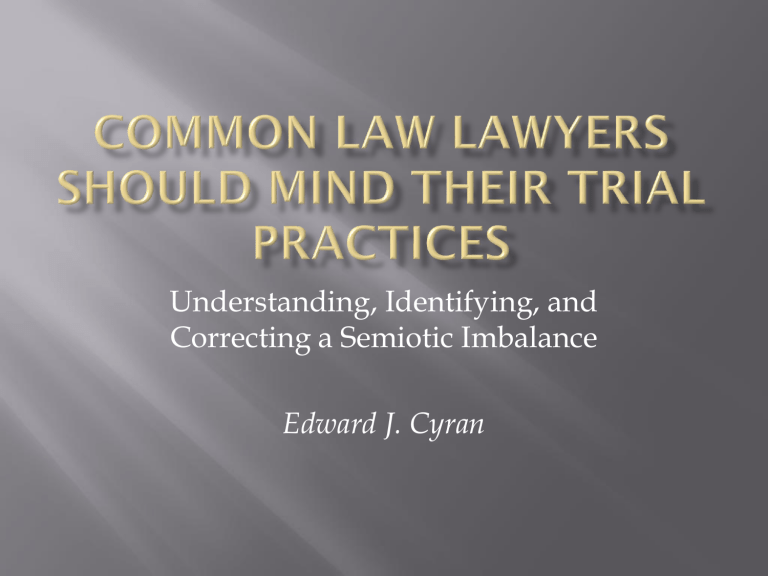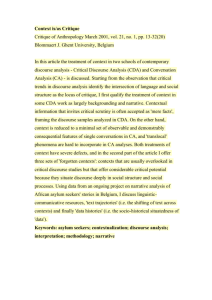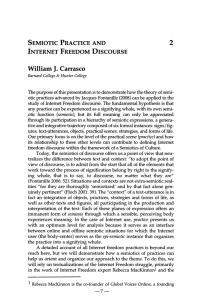Cyran Roundtable Presentation 2-25

Understanding, Identifying, and
Correcting a Semiotic Imbalance
Edward J. Cyran
A comparative lawyer’s response:
“...if [I] were innocent, [I] would prefer to be tried by a
Civil Law court, but if [I] were guilty, [I] would prefer to be tried by a Common Law court.”
A Civil Law Tradition , Merryman and Perez-Perdomo
(2007).
What is it?
How is artificial discourse different than natural discourse?
Decision-making process in communication
(authority vs. all people)
The character of a sign’s meaning (serving a goal of the discourse vs. pure development)
An institution achieves its goals by employing functionaries to define meaning.
Institution = Government
Goals = Justice, control, division of resources, etc.
Functionaries = Authorities = Master Signifiers
Examples
Legislators
Judges (Appellate and Trial)
Juries
Only those who communicate with the functionaries can influence the meaning of signs in discourse.
Examples
Lobbyists
Lawyers
You
Whenever communication is limited and the bounds of discussion narrowed, the semiotics of a process changes because potential meanings of signs are restrained.
Common Law
Stare Decisis – A Sea of Precedent
Constitutions
Legislative History
Public Policy
Civil Law
The Core Precept of Civil Law
Interpret the code with clarity, coherence, and consistency to uphold the law.
[Past rationales personally used by a judge
Truncated decisions of the ECJ or any superior court
(only because judge seeks to avoid reversal)]
The Civil lawyer is not permitted to brief the judge on the above two aspects of legal discourse.
Do not consider precedent
Not educated on precedent
Only authority is in the application of the facts of the case to the law
Elementary structures of signification exist in the deep structure of all discourses
Legal discourse does not have a deep structure, i.e. a genotext
Nonetheless, juries are still influenced by
Greimassian narratives. So, is such a structure of signification existing in the phenotext of legal discourse?
Greimas identified the deep structure as being thematic, with the process of meaning occurring in the narrative form
Greimas believed that we begin each thought with a “goal” (the goal doesn’t have to be discernible at first)
Each goal involves a sign or semiotic object as its
“subject”
The subject then proceeds through a narrative with actors influencing it
The narrative completes with a reflection upon the experience
Human action (whether real or fictional) thus appears meaningful in terms of a basic (“narrative”) sequence, which consists in the setting of goals (“contract”),
“performance” (or non-performance) of those goals, and “recognition” of that performance (or nonperformance)
-- Bernard Jackson, An Outline of Greimassian Semiotics
Fact-finders, whether juries or judges, process the factual story presented by the lawyer as a narrative
They also process the factual story presented by opposing counsel as a narrative
Subject = Fictional character of the Defendant or Plaintiff/Victim
Goal(s) = Fictional goal(s) that are expressed or implied by the storyteller; goal(s) that the factfinder independently conceives
Performance of Goals = What happens to the subject during the narrative
Recognition/Reflection upon Performance =
Takes place in jurors’ minds after hearing the story
With respect to the “Story in the Trial,” no semiotic differences exist between Common
Law and Civil Law
Jury listens to the story like the Civil Law
Judge does, and then applies the facts to the law
In Civil Law countries, lawyers cannot ask the witness questions, whether by direct or cross examination
This difference in procedure severely limits, if not eliminates, the second narrative – “The
Story of the Trial”
“Counsel, are you prepared to open?”
“Yes, Your Honor.”
... and it starts
Welcome to “The Commonwealth v. Van Fleet”
On the charge of Impersonating a Police Officer
Starring Plaintiff’s Counsel and Defendant’s
Counsel
Watch closely as they:
Compete with each other
Try to persuade you by their words and actions
Minimize each other’s arguments and tell you what
“impersonating a police officer” really means in this case
Also watch closely as they:
Object to each other
Argue with the judge
Guide the witness through his or her testimony on direct examination
Cross-examine the witness in a way that makes you feel like the attorney is the one telling the story
Don’t miss the Final Act!
What does this narrative do??
It manipulates meaning
No longer do you, the fact-finder, consider only the story in the trial, you consider the story of the trial
And not only that, but you consider all of the stories of the trial; including the one starring you, the jury
The existence of an unwanted effect upon the development of meaning caused by any practice or procedure
An unwanted effect in legal semiotics is one that damages the development of meaning, thereby carrying a substantial risk of preventing the law from being administered— that is, preventing it from realizing its goal of determining whether the defendant did or did not do something illegal
The potential for a semiotic imbalance in discourse exists when the discourse is susceptible to misuse, i.e. susceptible to the manipulation of meaning by an individual or a group of individuals
But, why care?
The ultimate goal of both the Common Law and
Civil Law is certainty
Inaccurate application of the law to facts means that the law is not certain—and if it is uncertain, law is a meaningless endeavor!
Two levels of understanding this phrase:
Within the legal tradition
The effect on the development of meaning (obfuscation of meaning)
Between the legal traditions
Civil Law avoids the situation, while Common Law has it
More scholarship is needed
Where else do such manipulations of meaning occur?
If a Common lawyer mindful of semiotics was to try to avoid obfuscating meaning, what would he do?
Anything different?
Would clients hire that lawyer??
“...if [I] were innocent, [I] would prefer to be tried by a
Civil Law court, but if [I] were guilty, [I] would prefer to be tried by a Common Law court.”
A Civil Law Tradition , Merryman and Perez-Perdomo
(2007).







